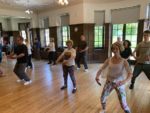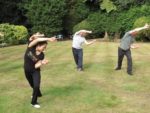
Qigong
 Qigong is an ancient Asian exercise and healing technique that is said to use controlled breathing, slow movement exercises and meditation to promote the circulation of life energy to improve health and healing.
Qigong is an ancient Asian exercise and healing technique that is said to use controlled breathing, slow movement exercises and meditation to promote the circulation of life energy to improve health and healing.
There are many types of Qigong each with practical applications and different theories about Qi (“subtle breath” or “vital energy”) and Gong (“skill cultivated through practise”). The two main types are internal Qigong and external Qigong.
Internal Qigong can be practised with or without a teacher. The two main aspects of the practice are controlled or deep breathing with slow body movements as an aerobic exercise, and relaxation. It often includes five steps: meditation, cleansing, recharging, circulating qi and dispersing qi. Each step involves special exercises, meditations and sounds.
External Qigong is performed by a practitioner who uses their hands to direct qi onto the participant.
 How might it work?
How might it work?
The theory is that ill health can be caused by blockages or imbalances of qi in the body. The exercises in internal Qigong are believed by many to stimulate balance, coordination, heart function, hormone balance and immune function.
“Qigong is a psychosomatic skill that adjusts body, breathing and mind into one,” explains Tony Childs from Health Qigong Federation UK. “Physical exercise combines with controlled breathing to lead the Qi energy to flow in the body following the acupuncture channels; this balances the body’s functions and improves mental and physical functions. The routines are simple and practical self-healing techniques.”
Experts suggest that Qigong is practised daily (ideally 30 minutes in the early morning or late evening) to achieve the greatest benefit.
The evidence
In general there is a lack of good quality scientific evidence into Qigong and arthritis. However, a few small studies have been carried out and a couple of reviews have been published recently.
One review looked specifically into Qigong and arthritis published in 2017 and concluded that Qigong should be recommended to people with arthritis. The team looked at the research base concerning the use of Qigong exercises to be used alongside usual treatment for promoting well-being among adults with arthritis and summarised:
“Qigong exercises-practiced widely in China for many centuries as an exercise form, mind-body and relaxation technique may be very useful as an intervention strategy for adults with different forms of painful disabling arthritis.”
A review of over 200 trials published in 2018 found some evidence that Qigong improved function and pain for people with fibromyalgia pain in the short term. Four years earlier, a review in Evidence-Based Complementary and Alternative Medicine concluded that there is considerable potential for Qigong – when practised regularly – to be a useful complementary practice for the management of fibromyalgia.
 Is it safe?
Is it safe?
Side effects are rare if Qigong is practised correctly and it is deemed to be extremely safe.
“We advise people to work with 60% to 70% of their strength and capabilities so that Qigong does not lead to fatigue, stress or inflammation of the joints,” says Tony.
Katheryne Gatehouse from Health Qiqong Federation UK comments:
“There are standing and seated forms of Qigong and movements can be adapted to disability or limitations. Anyone with chronic pain would benefit from the regular practice of Qigong. Many of our members have serious or long term medical issues. I have chronic long term pain from extreme scoliosis and arthritis of the neck, spine and wrists, and have found Qigong extremely beneficial – particularly for improving balance.”
People with severe osteoporosis, heart conditions, acute back pain, knee problems, sprains and fractures should take care and discuss their condition with the Qigong instructor before getting started.
What happens in a session?
“The class normally starts with some gentle loosening routines designed to focus on postural alignment, gentle body movements limb mobility, breathing and mindfulness,” explains Tony. “We then practise one of the Qigong routines either step by step or from start to finish. These can vary from six to 20 minutes. Finally, we wind down, stand or sit calmly and allow the body, mind and breath to return to its normal state, feeling energised, relaxed and peaceful.”
Where do I get it from?
“Ensure that you check a Qiqong instructor’s qualifications and background,” Tony recommends. “Attend one of their classes where you can meet other students and see if Qiqong suits you. Health Qigong Federation UK’s instructors are fully trained and qualified, so it might be worth getting in touch to find an instructor in your local area.
“Qiqong allows us to listen to our bodies, soften what needs to be softened and strengthen any weak areas, slowly and gently at the individual’s pace.”
Further information
- British Health Qigong Association, visit healthQigong.org.uk
- Health Qigong Federation UK, visit healthQigong.london or tel 020 8467 9988.
Potential benefits of Qiqong
- Increased range of joint movement
- Improved general fitness
- Enhanced muscle strength, coordination and flexibility
- Better balance
- Ease pain and stiffness
- Improved sleep
- Reduced anxiety and depression
Source: Tony Childs, Health Qigong Federation UK

Judy Bunzl
True story: Judy Bunzl, aged 61 years old, London
“I have had painful and swollen knee joints for over 20 years. In the past my symptoms would sometimes go into a remission where the swelling would reduce and my mobility would improve. But in January 2011 the swelling became more pronounced and my GP referred me to a rheumatology clinic.
“The diagnosis was complicated by the fact that I have psoriasis. X-rays confirmed osteoarthritis but the consultant queried that it could be psoriatic arthritis mimicking osteoarthritis. No specific diagnosis was made and it was decided that the condition would be monitored.
“Two years later I returned to the rheumatology clinic with a flare-up. This time I was also experiencing pain in my shoulder, neck and elbow joints. The consultant concluded that it “looked like psoriatic arthritis” and suggested he could start me on a nonsteroidal anti-inflammatory drug.
“Given the ambivalence of the diagnosis, I was not keen to start on any medication and wanted to see if I could continue to manage the condition.
“My most recent visit to rheumatology was in May 2019 and the diagnosis was still not clear. My inflammatory markers were normal and it was concluded that there would be little benefit to be had from medication as it was not considered that my symptoms were being driven by inflammation.
“So I continue without medication and with varying levels of pain/swelling in my knees with resultant reduced mobility. I have always instinctively felt that I should do as much as I can in terms of exercise, but I find walking more than a mile or so results in my knees seizing up and becoming painful to the extent that I cannot continue.
Discovery
“I found Qigong six years ago when I attended an open day at a community centre and have grown to love it.
“The movements are gentle and flowing and you can adapt them, depending on how much flexibility you have in your limbs/joints. There are numerous Qigong routines that aim to improve flexibility, balance and muscular strength. I can manage all the movements without any pain, unlike yoga where there is quite a lot that I cannot do.
“I practise Qigong daily. It helps keep me supple, improves strength in the muscles supporting my knees, and I find it is therapeutic as a form of meditation.
“Since beginning Qigong, I am much more aware of my posture. When I stand at the supermarket checkout or wait for the bus, I find I improve the way I am standing. I have become aware of how I breathe, and correct shallow breathing. This awareness of my posture and how I am breathing helps manage my pain.
“I advise anyone living in pain to try Qigong. It has definitely improved my quality of life and is widely available.”
